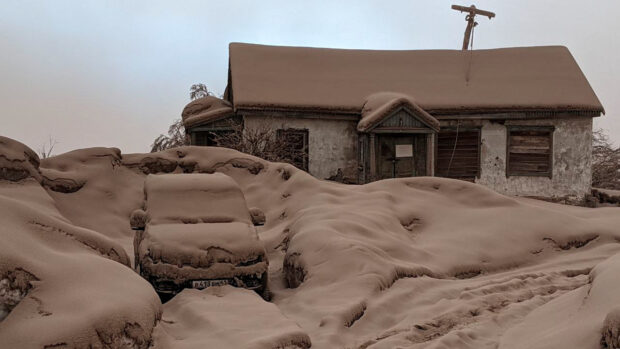
A view shows a house and a car covered in volcanic dust following the eruption of Shiveluch volcano in Kamchatka region, Russia, on April 11, 2023, in this picture obtained from a handout. Institute of Volcanology and Seismology/Handout via REUTERS
PETROPAVLOVSK-KAMCHATSKY, Russia — One of Russia’s most active volcanoes erupted on the far eastern Kamchatka peninsula on Tuesday, shooting a vast cloud of ash far into the sky that smothered villages in drifts of grey volcanic dust and triggered an aviation warning.
The Shiveluch volcano erupted just after midnight reaching a crescendo about six hours later, spewing out an ash cloud over an area of 108,000 square kilometers (41,699 square miles), according to the Kamchatka Branch of the Russian Academy of Sciences’ Geophysical Survey.
Lava flows tumbled from the volcano, melting snow and prompting a warning of mud flows along a nearby highway while villages were carpeted in drifts of grey ash as deep as 8.5 centimeters, the deepest in 60 years.
Pictures showed the cloud billowing swiftly over the forests and rivers of the far east and of villages covered in ash.
“The ash reached 20 kilometers high, the ash cloud moved westwards and there was a very strong fall of ash on nearby villages,” said Danila Chebrov, director of the Kamchatka branch of the Geophysical Survey.
“The volcano was preparing for this for at least a year… and the process is continuing though it has calmed a little now,” Chebrov said.
READ: Eruption in Russia’s Kamchatka threatens aviation — response team
About 300,000 people live on Russia’s vast Kamchatka peninsula, which juts into the Pacific Ocean northeast of Japan.
The volcano, one of Kamchatka’s largest and most active, would probably calm now, Chebrov said, though he cautioned that further major ash clouds could not be excluded. Chebrov said the lava flows should not reach local villages.
There were no immediate reports of casualties, though scientists said the volcano was still erupting 15 hours after the start of the eruption.
Drifts of ash
The Kamchatka Volcanic Eruption Response Team (KVERT) issued a red notice for aviation, saying “ongoing activity could affect international and low-flying aircraft.”
Some schools on the peninsula, about 6,800 km east of Moscow, were closed and residents ordered to stay indoors, head of the Ust-Kamchatsky municipal region Oleg Bondarenko said in a Telegram post.
“Because what I have just seen here with my own eyes, it will be impossible for children to go to school, and in general, the presence of children here is questionable,” Bondarenko said.
He said residents’ power had been restored and drinking water was being supplied.
Shiveluch has had an estimated 60 substantial eruptions in the past 10,000 years, the last major one being in 2007.
It has two main parts, the smaller of which – Young Shiveluch – scientists have reported as being extremely active in recent months, with a peak of 2,800 meters (9,186 feet) that protrudes out of the 3,283 meter-high Old Shiveluch.
RELATED STORIES
Russia’s Shiveluch volcano extremely active, threatens eruption – scientists
Three survivors rescued after nine die climbing icy Russian volcano